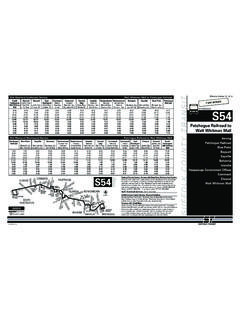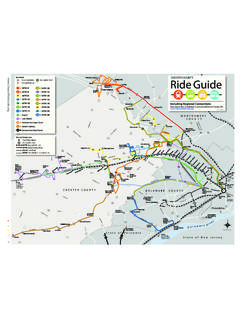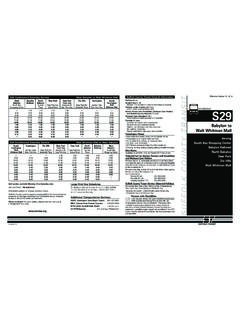Transcription of Mall Management: An analysis of customer …
1 International Journal of Scientific and Research Publications, Volume 5, Issue 3, March 2015 1. ISSN 2250-3153. mall management : an analysis of customer footfall patterns in Shopping Malls in India Dr Mamta Mohan *, Kavita Tandon **. *. Associate Professor, Amity University **. Amity University Abstract- mall management is a multifaceted and more complex (a) Demographics (b) Shopping orientations (c) Values and business proposition. mall culture is viewed as a significant Lifestyle (d) mall shopping attitude and behaviour. change in the lifestyle of Indians.
2 Malls have completely redefined the shopping experience. These malls have hoped to capitalize on teeming crowd, but it did not materialize, as per II. REVIEW OF LITERATURE. (Malls in India report, 2014) about 90% of the Malls are mall PATRONAGE: struggling to sustain. Today the deserted mall buildings Star Early researchers on mall patronage created gravitational City mall , DLF Promenade are leased out to corporate offices models to determine patronage for shopping areas using multiple and banquet halls owners. objective measures, such as distance, population density and The purpose of this study is to analyse the behaviour of mall mass(square footage of retail space)(Brunner and Mason, 1968.)
3 Shoppers that will drive footfalls in the malls. Like any other Huff,1963;Bucklin, 1967). Huff (1964) and Huff and Rust (1984). business thorough understanding of consumer is must, it is retail gravity model, provides a method for determining mall important to understand the consumer and shoppers profile in the patronage based on the principle of cost (accessibility) versus catchment area, before leasing out space to anchor tenants in utility (size). According to Moore and Mason (1969) who looked Malls. at the concept of retail centre patronage, the validity of these Shopping Malls, as an industry is driven by real estate, not models and other approaches to trading area analysis using the by retailing.
4 mall management has been identified as a critical concepts of mass and distance are debatable, since they presume factor for the success of mall . The study investigates the concept similar retail centre patronage decisions from shoppers with of mall management and indicates that success model of a mall similar incomes, educational levels and occupational does not depend on a single variable (retail brands) but a classification. At this point, studies started having a rising combination of multiple variables (real estate planning, zoning, customer focus.)
5 Later, studies focussed on subjective factors anchor tenants, accessibility, connectivity). such as image attributes and consumers' shopping motives (Bellenger et al.,1977; Gentry and Burns, 1977-8; Nevin and Index Terms- mall management , Shopper behaviour, yield Houston, 1980; Finn and Louviere, 1996; Stoltman, 1991). management Wakefield and Baker (1998) examined the association between three factors- tenant variety, mall environment and shopping involvement , on shoppers' excitement and desire to stay at the I. INTRODUCTION mall to understand antecedents and consequences of excitement T he purpose of this study is to understand the Indian mall shoppers by identifying their core characteristics including psychographics, demographics and shopping attitudes and its at the mall .
6 LeHew al. (2002) enhanced the loyalty concept and studied mall attributes that influenced loyal patronage of malls while Zhuang al. (2006) studied the effect of situational variables impact on shopping malls in India. on buying decisions. Hunter (2006) also determined the process by which image influenced patronage. 1. Introduction: mall development is taking place at a rapid pace in both DECLINE IN mall PATRONAGE. Tier I and Tier II cities in India, driven by the organized retail During the 1980s in the US, the mall was a fashionable sector.
7 For the discerning Indian consumer, the malls are proving destination for shopping and recreation (Kowinski, 1985). In the to be a panacea to all their shopping woes. early 1990s Fienberg and Meoli (1991) reported that half of all The packed parking areas, crowded food courts, brimming retail sales were through malls. However, recent trends indicate anchor stores and kids' zones are a testimony to the above. that mall patronage is declining. According to the international Increasing disposable incomes and paucity of quality time are Council of Shopping Centers, the mall industry has suffered creating a need for malls in the lives of affluent, urban Indian through several years in which sales growth has not even consumer.
8 But, malls are shocked to learn that while people are matched the rate of inflation (Pacelle, 1997). Moreover, while spending a lot of time at these malls, they are not spending a lot malls sales are declining, the amount of retail mall space is of money. The objectives of this research study are therefore to increasing. Industry experts suggest three reasons. First, there are classify mall shoppers by volume into heavy, medium and low too many malls that look exactly same, with too many stores rupee spenders and analyse difference between three groups in offering too much of the same merchandise (Ashley, 1997.)
9 International Journal of Scientific and Research Publications, Volume 5, Issue 3, March 2015 2. ISSN 2250-3153. Templin, 1997). Due to paucity of time, consumers seek to commitment that is evaluated through repurchase intention, not maximize their shopping time (Ashley, 1997). Third, fewer considering other better choices, price acceptance and plan to consumers are expressing they go to the mall because they relish communicate product or service to others is loyalty (Szczepanska the experience (Berry, 1996; Chandler, 1995). Despite the & Gawron, 2011).
10 Seemingly bleak outlook for malls, there are some notable success stories. Even though people's lives are reportedly more CONSUMER LOYALTY. time-pressed, they will find time to engage in activities they Dick and Basu (1994), regarded the power of association enjoy (Ashley, 1997). mall developers are attempting to attract between relative attitude of individual and their continuous customers by creating an exciting shopping experience designed purchasing behaviour as the consumer loyalty (Rittippant, to attract and keep them at the mall (Cockerham, 1995).)














